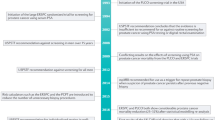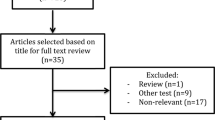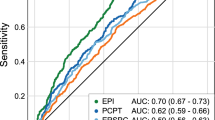Abstract
We present a new quantitative prostate-specific antigen (PSA) assay using a portable, point-of-care test (PSAwatch) and reader system (BioScan) for measuring PSA concentrations in the range from 0.5 to ⩽25 μg/l. Blood samples from patients (n=199) were submitted for laboratory PSA and also evaluated using PSAwatch and the BioScan system. PSA concentrations in 188 men were ⩽25 μg/l and studied. Correlation between the two methods was good (R2=0.88) with a standard error of 1.588. The regression line had a bias of −0.02 at the concentration of 4.00 μg/l. This is the first report of a quantitative, portable, point-of-care PSA test and reader system. PSAwatch may reduce the number of hospital visits for patients with prostate disease.
This is a preview of subscription content, access via your institution
Access options
Subscribe to this journal
Receive 4 print issues and online access
$259.00 per year
only $64.75 per issue
Buy this article
- Purchase on Springer Link
- Instant access to full article PDF
Prices may be subject to local taxes which are calculated during checkout




Similar content being viewed by others
References
Ablin RJ, Bronson P, Soanes WA, Witebsky E . Tissue- and species-specific antigens of normal human prostatic tissue. J Immunol 1970; 104: 1329–1339.
Wang MC, Valenzuela LA, Murphy GP, Chu TM . Purification of a human prostate specific antigen. Invest Urol 1979; 17: 159–163.
Polascik TJ, Oesterling JE, Partin AW . Prostate specific antigen: a decade of discovery what we have learned and where we are going. J Urol 1999; 162: 293–306.
Roehrborn CG, Malice M, Cook TJ, Girman CJ . Clinical predictors of spontaneous acute urinary retention in men with LUTS and clinical BPH: a comprehensive analysis of the pooled placebo groups of several large clinical trials. Urology 2001; 58: 210–216.
Mochtar CA, Kiemeney LA, Laguna MP, van Riemsdijk MM, Barnett GS, Debruyne FM . Prognostic role of prostate-specific antigen and prostate volume for the risk of invasive therapy in patients with benign prostatic hyperplasia initially managed with alpha1-blockers and watchful waiting. Urology 2005; 65: 300–305.
D'Ambrosio G, Samani F, Cancian M, De Mola C . Practice of opportunistic prostate-specific antigen screening in Italy: data from the Health Search database. Eur J Cancer Prev 2004; 13: 383–386.
Hardie C, Parker C, Norman A, Eeles R, Horwich A, Huddart R et al. Early outcomes of active surveillance for localized prostate cancer. BJU Int 2005; 95: 956–960.
AOU. Action On Urology Good Practice Guide – Outcomes from 32 Action On Urology Sites. NHS Modernisation Agency, p 31. March 2005.
Lintz K, Moynihan C, Steginga S, Norman A, Eeles R, Huddart R et al. Prostate cancer patients' support and psychological care needs: survey from a non-surgical oncology clinic. Psycho-oncology 2003; 12: 769–783.
Milford Ward A, Catto JWF, Hamdy FC . Prostate specific antigen: biology, biochemistry and available commercial assays. Ann Clin Biochem 2001; 38: 633–651.
Blijenberg BG, Yurdakul G, Van Zelst BD, Bangma CH, Wildhagen MF, Schroder FH . Discordant performance of assays for free and total prostate-specific antigen in relation to the early detection of prostate cancer. BJU Int 2001; 88: 545–550.
R Development Core Team 2006. R: A Language and Environment for Statistical Computing. R Foundation for Statistical Computing, Vienna, Austria. ISBN: 3-900051-07-0, URL: http://www.R-project.org.
AOU. Action On Urology Good Practice Guide – Outcomes from 32 Action On Urology Sites. NHS Modernisation Agency, p 4. March 2005.
AOU. Action On Urology Good Practice Guide – Outcomes from 32 Action On Urology Sites. NHS Modernisation Agency, p 6. March 2005.
Cancer Services Collaborative. Improvement Partnership. http://www.modern.nhs.uk/cancer.
Singh R, Cahill D, Popert R, O'Brien TS . Repeating the measurement of prostate-specific antigen in symptomatic men can avoid unnecessary prostatic biopsy. BJU Int 2003; 92: 932–935.
Acknowledgements
We thank the nursing staff in the Urology clinic at Wexham Park Hospital and the Bridge Clinic for their support with this project. This work was financially supported by Mediwatch Plc. Mr Omer Karim and Mr Mark Emberton are Nonexecutive Directors of Mediwatch Plc.
Author information
Authors and Affiliations
Corresponding author
Rights and permissions
About this article
Cite this article
Karim, O., Rao, A., Emberton, M. et al. Point-of-care PSA testing: an evaluation of PSAwatch. Prostate Cancer Prostatic Dis 10, 270–273 (2007). https://doi.org/10.1038/sj.pcan.4500962
Received:
Revised:
Accepted:
Published:
Issue Date:
DOI: https://doi.org/10.1038/sj.pcan.4500962



